nr.
Narysov nr.Pribram
grid loc: JN69XP 590 m a.s.l. distr.:BPB
This is my 2nd official QTH since 2002. This is the place, where most of my home made
& experimental antennas were tested and used. This is my main contest QTH for 6m and 2m band contests (if not operating portable). For HF I use usually there inverted
V dipoles or different verticals. For 6m and 2m bands different sets of Yagi antennas are used (single or stacked).
Vertical monoband antenna "fishing
rod" for 10m band. It is constructed as ½
lambda wire built into 6m long fishing rod. Fed at high impedance
by ¼ lambda coax match RG92. It is located above chimney, about
6m above ground. There are no tuned radials. Surprisingly I had better
results with it for DX (W, VE, LU, JA), than with 2-element cubical quad
Quad was better for shorter distances (Europe, VU, north of Africa).
Currently (since 2017) the propagation conditions are so poor, that it is only "prepared to be used".
Similar design is used for 20m band vertical, e.g. made as ½ lambda
long wire inside laminate rod fed at its high impedance bottom by 93 ohm coax "J" impedance transformer.
It is about 10m long so it cannot be mounted behind the chimney of course,
but stands separately in the garden at 2-3m portable mast and is kept vertical by 3-4 kevlar thin ropes.
Once it was mounted at the top of 10m mast, but the result was not much different from 3m portable mast.
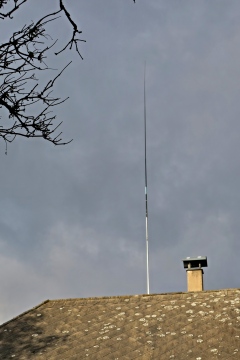
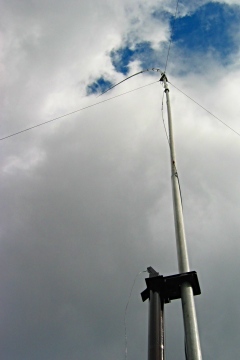
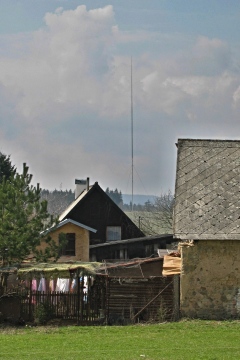
Inverted V multiband dipoles - 15
/ 20 / 30m band.
Consists of 3 dipole antennas in
parallel. Center is about 6m up. Symmetry was achieved by inductance of
RG58 coax ferrite toroid coil (1 pc of 2" toroid).
Because of propagation conditions I use now rather simple dipoles or TTFD antenna.
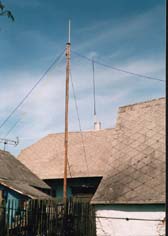
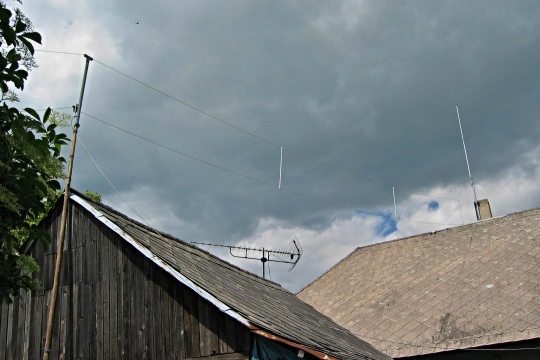
Cubical Quad - 2 element - 10 / 15m
band.
Each radiator is fed separately at its diagonal by 1/4 lambda long 75 ohm coax
cable to match 50 ohm cable to rig. Symmetry was achieved by 1:1 balun - inductance
at radiator feeding points. 75 ohm coax runs through 5" column of 1/2" ferrite toroids.
Switching of bands is done remotely by relay ... one of 75 ohm cables at a time is connected to 50 ohm cable running to rig.
Center of "spider" was originally about 6m up held by wooden rod and there was no rotator.
So I needed to run out from house to turn antenna into proper direction by rope and then I need to run back again (:-).
This was modified by "upgrade" of metalic central spider by 2015 to fit into 10m mast used also for Yagi antennas.
Anyhow 15m and 10m bands are usually silent those years.
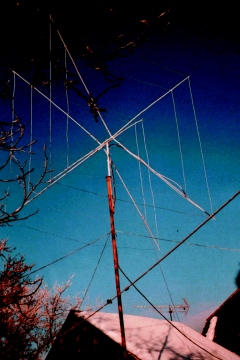
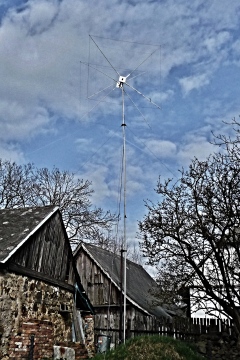
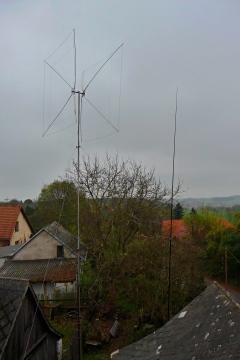
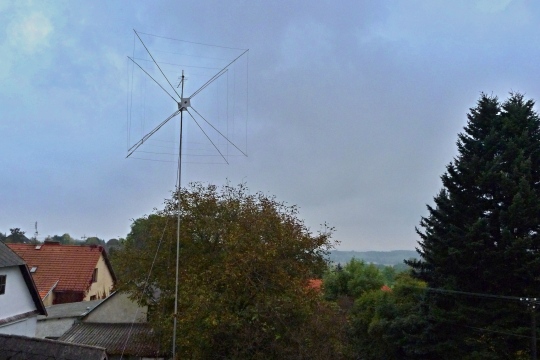
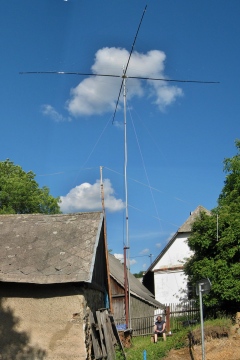
Spider beam - 10 - 15
- 20m band.
This nice antenna was used here for 4 years. It worked perfect. Since 2006 there is no way how to raise it up because of new space limitations.
Version 1 doesn't support 18 and 12m bands. New versions are available now from producer.
Antenna was moved to QTH#3 by autumn 2019. I will see, how it works after such a long time. Hoping it have not become lazy.
Yagi 7 over 7 element stack for 2m band
It is DK7ZB design. Splitter is created as T-join of two 50 ohm coaxes working also as impedance transformers to 100 ohm impedance.
Upper coax is lambda* 7/4 long, bottom coax lambda* 3/4 long. Span between antennas is about 2,5 meters.
Croatia, Slovenia and Italian contest stations can be worked even with QRP 5W power of my FT817 - not only CW, but sometimes also SSB.
This stack can be combined with single 3 element DK7ZB Yagi for 6m band - it fits with some contests.
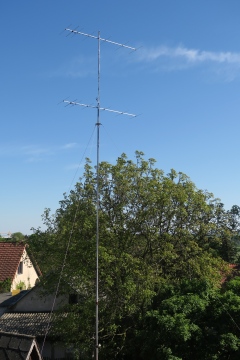
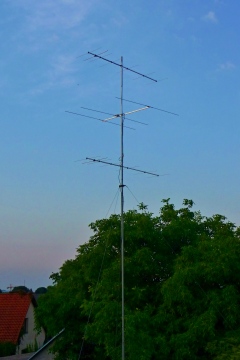
Yagi 5 over 5 element stack for 2m band
That 5 element Yagi antenna is designed for portable operation. And this stack is used primarily for portable.
But if there is no time or suitable weather for visiting some hill, it can work "behind the chimney" as well. Direction is then mechanically controled by hand.
Picture shows its combination with 9-element F9FT antenna for 70cm band.
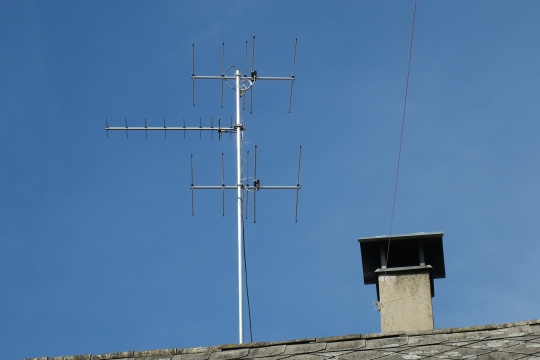
Yagi 3 over 3 element stack for 6m band
Again DK7ZB basic design, but - home made. Impedance transformer to 50 ohm is built into antenna itself.
Single antenna can be used straight without additional impedance transformation.
Mechanical design also enables fast assembly / disassembly into slim 1.5m long package of pieces for portable operation.
For stack operation splitter is made as T-join of two 75 ohm coaxes working also as impedance transformers from 50 ohm to 100 ohm impedance.
Upper coax is lambda*5/4 long, bottom coax lambda*1/4 long. Stack span is about 4.5 meters.
Single Yagi can be mounted again "behind the chimney" if needed.
Up to now I haven't used single one as portable, even it is contructed so that it is possible. I believe sporadic Es layer effects the result much more than altitude.
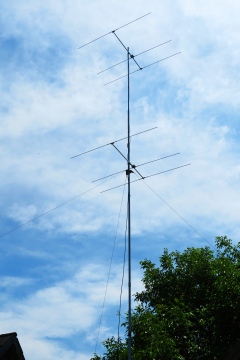
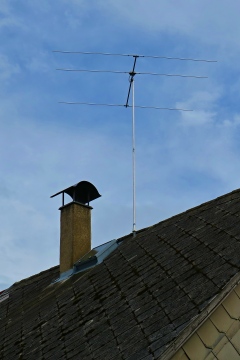
Magnetic loop - 10 - 13
- 15m band.
Main loop is made of 1/2" copper tube. Diameter about 1m. Feeding is provided by standard small coax loop.
Main loop is positioned horizontally and located below roof of building - about 5m above the ground.
Tuning capacitor is created by RG213 coax shifted into the copper tube by screw.
Motor is controlled and capacitor position is indicated remotely through UTP cable.
I can use it only for QRP, because otherwise PE insulation of "coax capacitor" tends
to melt and also electromagnetic field below antenna becomes too strong
for human health. Anyhow it works well (if the roof is dry) also for DX.
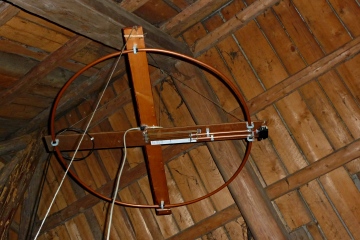
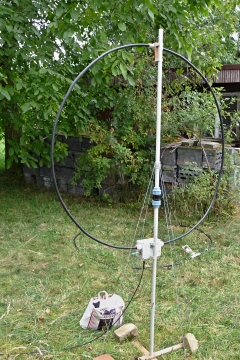
Magnetic loop - 40
- 80m band.
Made of older UHF coax cable (has Cu tube as shield). Diameter is about 1.3m. Loop is positioned vertically
and located near the ground at wooden / plastic stand. Tuning capacitor is not high voltage type.
So antenna is designed for QRP only usage and portable operation.
Feeding is done by transformer: loop goes through ferite toroid with 5 to 14 turns fed by 50ohm cable. Tuning is manual.
















